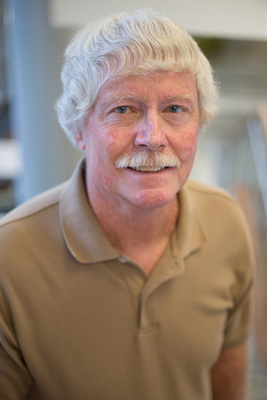Professor Emeritus
3122 East Science Hall, Science & Engineering Complex
(205) 934-8309
Research and Teaching Interests: Ecology, Population Biology, Animal Natural History, Aquatic Environmental Biology
Office Hours: By appointment
Education:
- B.S., Washington University (St. Louis), Biology
- Ph.D., Washington University (St. Louis), Reptile Natural History
My interest in the field and environmental areas of biology have their roots in my childhood growing up in the Ozark foothills of Missouri. Here I played in the creeks and rivers and turned over rocks and logs looking for critters. This led to me desiring to pursue an academic and research career where I could continue and expand my early interests. I have now been at UAB for 40+ years and have taught Introductory Biology, Natural History of the Vertebrates, Ecology, Environmental Biology, and Biology Study Away courses. My research interests have focused on the natural history of various reptiles, amphibians, and fish, with particular emphasis on human impacts on these species.
I was Chair of the Department of Biology from 2000-2008 and have served on a number of Boards of Directors of local and state environmental organizations, including Forever Wild of Alabama. I have also served as President of the Alabama Fisheries Association, the Alabama Academy of Science, and the Association of Southeastern Biologists.
-
Research Interests
Research in my laboratory has centered around two major areas: animal natural history and aquatic environmental biology. These studies are approached from both the field and laboratory perspective.
Natural history studies on selected animals generally emphasize reproductive cycles, life history strategies, and population dynamics. Several species of reptiles, amphibians, fish, and marine invertebrates have been objects of study. Many of these investigations have been performed to provide basic biological and population information on potentially endangered species or those of possible economic importance.
Studies on aquatic environmental biology involve interaction with other faculty members. Water quality evaluations by both chemical and biological means are performed. Assessments of fish and benthic invertebrate communities are made by seasonal sampling. Of special interest is the use of biological organisms as indicators of the health status of aquatic ecosystems. Recent studies have investigated the effects of increasing urbanization on the Cahaba River and the possible effects of the Gulf oil spill on coastal marsh keystone species.
-
Recent Courses
- BY 435/535: Natural History of the Vertebrates — a survey of the vertebrate species of Alabama with field trips to various habitats.
- BY 470/570: Ecology — a survey of ecological communities and their dynamics; principles of population biology.
- BY 267, 268, 269 — Sudy Away courses to unique ecosystems of the world; trips to Bahamas to study the coral reefs, the Galapagos Islands to observe the divergence of wildlife between islands, and Costa Rica to study the tropical rainforest.
-
Graduate Students
- Matriculated 12 M.S. and 11 Ph.D. students.
-
Select Publications
- Coleman AT, Roberge T, Wibbels T, Marion K, Nelson D, Dindo J, "Size-based mortality of adult female Diamond-backed Terrapins (Malaclemys terrapin) in Blue Crab traps in a Gulf of Mexico population," Chelonian Conservation and Biology 13 (No. 2, 2014): 140-45.
- Coleman AT, Wibbels T, Marion K, Roberge T, Nelson D, Dindo J, "Dispersal behavior of Diamond-backed Terrapin post-hatchlings," Southeastern Naturalist 13 (No. 3, 2104): 572-86.
- Melancon S, Angus R, Marion K, "Demographic comparisons between reservoir-dwelling and stream-dwelling populations of a threatened turtle (Sternotherus depressus Tinkle and Webb)," Southeastern Naturalist 12 (No. 4, 2013): 684-91.
- Melancon S, Angus R, Marion K, "Growth of the Flattened Musk Turtle (Sternotherus depressus Tinkle and Webb)," Southeastern Naturalist 10 (No. 3, 2011): 399-408.
- Blackwell E, Angus R, Cline G, Marion K, "Natural growth rates of Ambystoma maculatum in Alabama," Journal of Herpetology 37 (2003): 608-12.
- Onorato D, Angus R, and Marion K, "Historical changes in the ichthyofaunal assemblages in the upper Cahaba River in Alabama associated with extensive urban development in the watershed," The Journal of Freshwater Ecology 15 (No. 1, 2000): 47-63.
- Onorato D, Angus R, Marion K, "Longitudinal variation in the ichthyofaunal assemblages of the upper Cahaba River: Possible effects of urbanization in a watershed," Journal of Freshwater Ecology 13 (No. 2, 1998): 139-54.
- Marion K, Cox W, Ernst C, "Prey of the Flattened Musk Turtle, Sternotherus depressus," Journal of Herpetology 25 (No. 3, 1991): 385-87.
- Ernst C, Cox W, Marion K, "The distribution and status of the Flattened Musk Turtle, Sternotherus depressus," Tulane Studies in Zoology and Botany 27 (No. 1, 1989): 1-20.
-
Academic Distinctions and Professional Societies
- Provost’s Award for Excellence in Academic Engagement and Global Citizenship, 2013
- Fellow of the Alabama Academy of Science, 2008
- UAB Odessa Woolfolk Community Service Award, 2005
- Association of Southeastern Biologists Meritorious Teaching Award, 1999
- School of Natural Sciences and Mathematics Most Outstanding Faculty Award, 1986
- Served as President of the Association of Southeastern Biologists (1993-1994), the Alabama Fisheries Association (1992-1993), and the Alabama Academy of Science (1991-1992)
